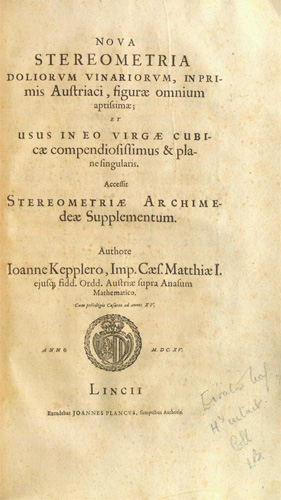- About MAA
- Membership
- MAA Publications
- Periodicals
- Blogs
- MAA Book Series
- MAA Press (an imprint of the AMS)
- MAA Notes
- MAA Reviews
- Mathematical Communication
- Information for Libraries
- Author Resources
- Advertise with MAA
- Meetings
- Competitions
- Programs
- Communities
- MAA Sections
- SIGMAA
- MAA Connect
- Students
- MAA Awards
- Awards Booklets
- Writing Awards
- Teaching Awards
- Service Awards
- Research Awards
- Lecture Awards
- Putnam Competition Individual and Team Winners
- D. E. Shaw Group AMC 8 Awards & Certificates
- Maryam Mirzakhani AMC 10 A Awards & Certificates
- Two Sigma AMC 10 B Awards & Certificates
- Jane Street AMC 12 A Awards & Certificates
- Akamai AMC 12 B Awards & Certificates
- High School Teachers
- News
You are here
Kepler: The Volume of a Wine Barrel - Kepler's 'Nova stereometria doliorum vinariorum'
Kepler reported his results on wine barrels in his 1615 book, Nova stereometria doliorum vinariorum (New solid geometry of wine barrels). The word Stereometria is from the Ancient Greek stereos that means solid or three-dimensional and metron that means a measure or to measure. Stereometria then means the art of measuring volumes, or solid geometry. Doliometry is an old-fashioned word from the Latin dolium that means a large jar or barrel.
This book is a systematic work on the calculation of areas and volumes by infinitesimal techniques. Building on the results of Archimedes, it focuses on solids of revolution and includes calculations of exact or approximate volumes of over ninety such solids (Edwards, p. 102). Today we use integral calculus to solve these kinds of problems.

Figure 4. Title page of Kepler's 1615 Nova stereometria doliorum vinariorum. (Image used by permission of the Carnegie Mellon University Libraries)
The full text of the original Latin version of Kepler's Nova stereometria doliorum vinariorum (1615) can be viewed in electronic format, courtesy of the Posner Memorial Collection of the Carnegie Mellon University Libraries. Two pages of Kepler's own German version of his Nova Stereometria, published in 1616 and titled Auszug aus der uralten messekunst Archimedes, can be viewed in Convergence's Mathematical Treasures.
According to C.H. Edwards (p. 102):
Kepler's approach in [his Stereometria was] to dissect a given solid into an … infinite number of infinitesimal pieces, or solid 'indivisibles', of a size and shape convenient to the solution of the particular problem.
Kepler then added up the volumes of the component pieces to obtain the volume of the given solid. Kepler's infinitesimal elements had to possess the same dimensions as the body he wanted to measure. That is, if he wanted to calculate an area, he added up area elements and if he wanted to calculate a volume he considered solid infinitesimal elements with volume.
Kepler began his book with the simple problem of determining the area of the circle. He regarded the circle as a regular polygon with an infinite number of sides and therefore composed of infinitely many infinitesimal triangles of which the bases were the sides of the polygon, the heights or altitudes the radius of the circle, and the vertices opposite the bases the center of the circle (Boyer, p. 108). Since the area of a triangle is one-half the product of its base and height, the total area of the circle was then given by half the product of its perimeter (or circumference) and its radius.
 |
Kepler in MatematicasVisuales - The Area of a Circle Kepler used an intuitive infinitesimal approach to calculate the area of a circle. |
Similarly, by thinking of the sphere as being composed of an infinite number of infinitesimal cones whose vertices were the center of the sphere and whose bases made up the surface of the sphere, Kepler was able to compute the volume of the sphere. Since the volume of a cone is one-third the product of the area of its base and its height or altitude, the total volume of the sphere was then given by one-third the product of its surface area and its radius.
 |
Kepler in MatematicasVisuales - Volume of a Sphere Kepler used an intuitive infinitesimal approach to determine the relationship between the volume of a sphere and its surface area. |
Kepler also rotated a circle about a line external to the circle, and calculated, by infinitesimal methods, the volume of the torus thus generated. He then extended his work to solids not treated by the ancients. Some of his summations are remarkable anticipations of results found later by integral calculus (Boyer, pp. 108-109).
 |
In Wolfram MathWorld, we can see solids of revolution defined by Kepler. |
Roberto Cardil (MatematicasVisuales), "Kepler: The Volume of a Wine Barrel - Kepler's 'Nova stereometria doliorum vinariorum'," Convergence (January 2012), DOI:10.4169/loci003499




